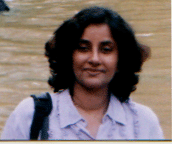

Dr Chandrika Varadachari is an interdisciplinary scientist working in the interfaces of chemistry with Earth Science, Environmental Science and Material Science. Her research is fusion of several disciplines of applied sciences and technology mostly in the geology-mathematics-thermodynamics and technology-chemistry-agriculture interfaces and materials modelling and design.
Dr Varadachariís PhD thesis was on the development of processes for the conversion of waste micas into potash fertilizers. She successfully developed unique processes for utilisation of muscovite wastes for producing potassium phosphates. Biotite mica (black mica) which has no commercial utility at present, was converted to potassium sulphate (a high value fertilizer), ammonium alum and pure silica. The process was subsequently upgraded to a pilot level
Dr Varadachari later pioneered the development of a new category of slow-release fertilizers, now termed bio-release fertilizers. These compounds, which contain various micronutrient ions, are not only water insoluble but also completely bio-available (unlike all previous slow-release fertilizers). The bio-release fertilizers are non-leachable and non-polluting; yet they contain nutrients in a chemical form that is extractable by plant roots.
Studies on clay-humus complexes lead to the development of a comprehensive picture of interactions of soil minerals with organic substances. These concepts have been developed based on an in-depth study of crystal structures, chemical reactions and high precision analytical data.
Dr
Varadachari has incorporated new thermodynamic concepts and non-conventional
mathematics to understand the behaviour of mineral systems. This has resulted in
improved perceptions of phase equilibria and a new methodology for defining
variable composition minerals by fuzzy mathematics and a very novel method for
derivation of graded phase diagrams incorporating fuzzy logic.
New
fields of study currently undertaken are on the applications of thermodynamics
and quantum mechanics for virtual design of ceramics. Another area that Dr
Varadachari is now working on is the use of ab initio methods for modelling
abiotic polymerisation of biological macromolecules
to understand the origin of life on Earth.
Doctorate students & their thesis:
Dr Sanjay Ray : Novel slow-releasing micronutrient fertilizers :Formulation, synthesis and applicability.
Dr Ajijul H Mondal : Some aspects of clay-humus formation.
Dr Md Kudrat : Mineral equilibria in silicate systems.
Dr Hasmot Saikh : Effect of deforestation and cultivation on some soil chemical properties.
Dr Tarit Chattopadhyay : Investigations on the complexes of humic substances with some inorganic soil components.
Dr Sanjib Kar : Ion binding in soil humic substances.
Dr Partha K Chandra : Polyphosphate based micronutrient fertilizers.
Dr Nayan Ahmed : Studies on naturally occurring clay-humus complexes.
Dr Gautam Goswami : Studies on oxides and hydrous oxides of iron.
Ms Ishita Bhattacharya
Ms Gargi Mukherjee
Ms Sruti Das
Mr Shiladitya Bandopadyay
Awards
received :
INSA
(Indian National Science Academy) Young Scientist Award
First recipient from Agricultural
Chemistry and/or Soil Science.
DST
(Department of Science & Technology, Government of India)
Young Scientist (1988). Second recipient from West Bengal.
UNESCO-ROSTSCA
Award (1990) in Chemistry.
Calcutta
University Gold Medalist.
Fellow
and (at present) Sectional Committee Member,
West Bengal Academy of Science & Technology, Calcutta
Projects : Dr Varadachari has conducted eleven sponsored research projects as the Principal Investigator
A few research publications :
(1)
Development
of a Novel Slow-Releasing Iron-Manganese Fertilizer Compound. I. Bhattacharya,
S.Bandyopadhyay, C Varadachari and
K Ghosh : Industrial & Engineering Chemistry Research : 46 : 2870-2676
(2) Fuzzy phase diagrams of clay minerals : Varadachari C : Clays & Clay Minerals : 54 616-625 (2006)
(3) Discriminant analysis of clay mineral compositions : C. Varadachari & G. Mukherjee : Clays & Clay Minerals : 52 311-320, (2004).
(4) Varadachari C, Mukherjee G, Goswami D P and Chakraborty M K (2003) Understanding clay minerals with fuzzy mathematics, Naturwissenschaften 90 44-48.
(5) Application of the improved regression method to derive DG0f of non-stoichiometric clay minerals and their correlations with compositional parameters : M. Kudrat, C. Varadachari & K. Ghosh : Chemical Geology (Netherlands) : 168 : 225-238 (2000).
(6) An algorithm and program in C language for computation of standard free energy of formation of clay minerals : M. Kudrat, K.P. Sharma, C. Varadachari & K. Ghosh : Computers & Geosciences (UK) 25 : 241-250 (1999).
(7) Evaluation of standard free energies of formation of clay minerals by an improved regression method : C. Varadachari, M. Kudrat & K. Ghosh : Clays & Clay Minerals (USA) 42 : 298-307 (1994).
(8) Constructing phase diagrams for silicate minerals in equilibrium with an aqueous phase : A theoretical approach : C. Varadachari : Soil Science (USA) 153 : 5-12 (1992).
(9) Saikh H, Varadachari C and Ghosh K (1998) Changes in carbon, nitrogen and phosphorus levels due to deforestation and cultivation : A case study in Simlipal National Park, India, Plant & Soil 198 137-145.
(10) Ray S K, Varadachari C and Ghosh K (1997) Novel slow-releasing micronutrient fertilizers 2. Copper Compounds, Journal of Agricultural & Food Chemistry 45 1447-1453.
(11) Varadachari C, Kudrat M and Ghosh K (1994) Evaluation of standard free energies of formation of clay minerals by an improved regression method, Clays & Clay Minerals 42 : 298-307.
(12) Varadachari C, Mondal A H, Nayak D C and Ghosh K (1994) Clay-humus complexation : Effect of pH and the nature of bonding, Soil Biology & Biochemistry 26 : 1145-1149.
(13) Ray S K, Varadachari C and Ghosh K (1993) Novel slow-releasing micronutrient fertilizers. I. Zinc compounds, Industrial & Engineering Chemistry Research 32 1218-1227
(14) Varadachari C (1992) An investigation on the reaction of phosphoric acid with mica at elevated temperatures, Industrial & Engineering Chemistry Research 31 357-364
(15) Barman A K, Varadachari C and Ghosh K (1992) Weathering of silicate minerals by organic acids : I. Nature of cation solubilisation, Geoderma 53 : 45-63.
(16) Varadachari C, Mondal A H and Ghosh K (1991) Some aspects of clay-humus complexation : Effect of exchangeable cations and lattice charge, Soil Science 151 : 220-227.
(17)Nayak D C, Varadachari C and Ghosh K (1990) Influence of organic acidic functional groups of humic substances in complexation with clay minerals, Soil Science 149 : 268-271.